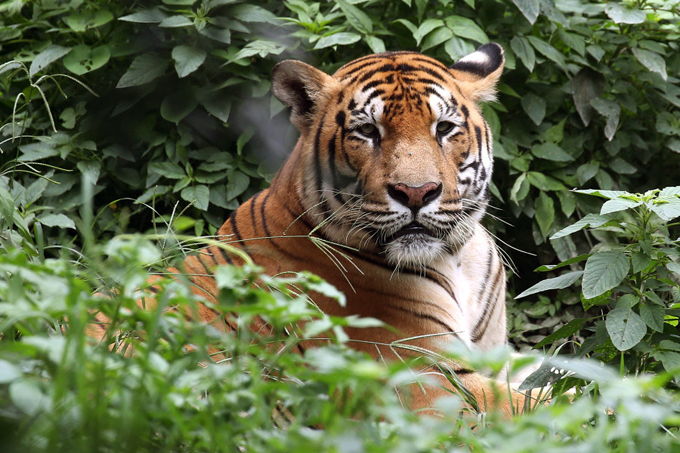Chitwan National Park - The First National Park and World Heritage Site of Nepal.

Chitwan National Park is the first national park of Nepal. It was established in 1973 as the Royal Chitwan National Park and was granted the status of a World Heritage Site in 1984. It covers an area of 952.63 km2 (367.81 sq mi) in the subtropical Inner lowlands of south-central Nepal known for its biodiversity. It ranges in elevation from about 100 m (330 ft) in the river valleys to 815 m (2,674 ft) in the Sivalik Hills. In the north and west of the protected area the Narayani-Rapti river system forms a natural boundary to human settlements. Adjacent to the east of Chitwan National Park is Parsa National Park, contiguous in the south is the Indian Tiger Reserve Valmiki National Park. Its huge block of alluvial grasslands and subtropical moist deciduous dense forests are home to rare mammals like one-horned rhinos and Bengal tigers. The park shelters numerous bird species, including the giant hornbill. Dugout canoes traverse the northern Rapti River, home to crocodiles. Inside the park is Balmiki Ashram, a Hindu pilgrimage site.

Chitwan has a humid subtropical monsoon influenced climate with high humidity all through the year. The area is located in the central climatic zone of the Himalayas, where monsoon starts in mid June and eases off in late September. The typical vegetation of the Inner Terai is Himalayan subtropical broadleaf forests with predominantly sal trees covering about 70% of the national park area. On recently deposited alluvium and in lowland areas groups of catechu with rosewood predominate, followed by groups of kapok with rhino apple trees, the fruits of which rhinos savour so much. Understorey shrubs of velvety beautyberry, hill glory bower and gooseberry offer shelter to a wide variety of species. Terai-Duar savanna and grasslands cover about 20% of the park's area. More than 50 species of grass are found here including some of the world's tallest grasses like the elephant grass called Saccharum ravennae, giant cane, khagra reed and several species of true grasses. Kans grass is one of the first grasses to colonise new sandbanks and to be washed away by the yearly monsoon floods.

The wide range of vegetation types in the Chitwan National Park is haunt of more than 700 species of wildlife and apart from king cobra and rock python, 17 other species of snakes, tortoise and monitor lizards. The Narayani-Rapti river system, their small tributaries and myriads of oxbow lakes is habitat for 113 recorded species of fish and crocodiles. Chitwan National Park is home to 68 mammal species. The "king of the jungle" is the Bengal tiger. The alluvial floodplain habitat of the Terai is one of the best tiger habitats anywhere in the world. Indian leopards are most prevalent on the peripheries of the park. They co-exist with tigers. Chitwan is considered to have the highest population of sloth bears with an estimated 200 to 250 individuals. Smooth-coated otters inhabit the numerous creeks and rivulets. Bengal foxes, spotted linsangs and honey badgers roam the jungle for prey. Striped hyenas prevail on the southern slopes of the Churia Hills. During a camera trapping survey in 2011, dholes were recorded in the southern and western parts of the park, as well as Indian jackals, fishing cats, jungle cats, leopard cats, crab-eating mongooses, yellow-throated martens, large, small Indian and Asian palm civets.

Every year dedicated bird watchers and conservationists survey bird species occurring all over the country. In 2006 they recorded 543 species in the Chitwan National Park, much more than in any other protected area in Nepal and about two-thirds of Nepal's globally threatened species. Additionally, 20 black-chinned yuhina, a pair of Gould's sunbird, a pair of blossom-headed parakeet and one slaty-breasted rail, an uncommon winter visitor, were sighted in spring 2008. Apart from the resident birds about 160 migrating and vagrant species arrive in Chitwan in autumn from northern latitudes to spend the winter here, among them the greater spotted eagle, eastern imperial eagle and Pallas's fish-eagle. Common sightings include brahminy ducks and goosanders.
.jpg)
There are several daily flights between Kathmandu and Bharatpur, which take only 20 minutes once you're in the air. The city of Bharatpur is the air hub for the Chitwan National Park. Flying is by far the easiest and quickest way of getting between Kathmandu and Chitwan. Taxis can be found easily at Bharatpur Airport. Tourist buses are another way to get from Kathmandu to Chitwan. The Chitwan National Park is about 60 miles (96 kilometers) from Kathmandu, and on a good day this journey may only take about five hours.
 EN
EN